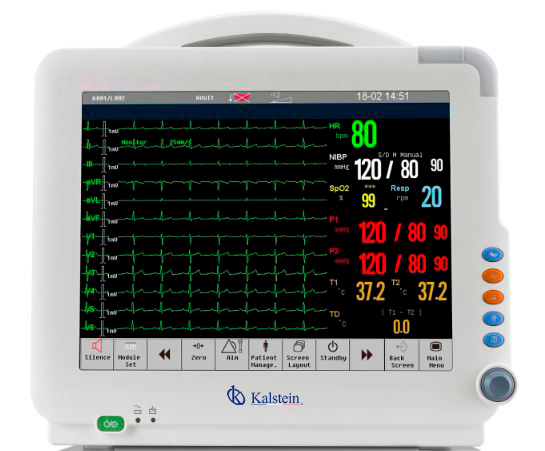The patient monitor is a multifunctional instrument designed to monitor the vital signs of adult and pediatric patients. It is found in hospitals and clinics and should only be operated by qualified personnel. The equipment is designed to manifest a set of parameters in patients for the purpose of exposing medical data in the trend database, designing alarms and observations.
It enables complete analysis of the patient’s physiological conditions, using the instant recording function and displayed measurements such as: HR (heart rate), RR (respiratory rate), BP (blood pressure), SatO2 (oxygen saturation) and T° (peripheral body temperature).
Patient monitor functions
Monitoring patient vital signs with this equipment means receiving reliable data reflected in the monitor, thanks to parameters captured by electrical signals from pulses emitted by the myocardium. All this is aimed at studying the patient’s physiological system, linked by electrodes in the body, which show and store respiratory movements of the thorax to measure heart rate, blood pressure and O2 saturation will depend on the intensity of the pulse.
Consequently, the appropriate use of the patient monitor will depend on medical knowledge and should respect the following parameters:
- Switch on computer and select schedule.
- Clean the alcoholic area where the electrodes will be installed on the patient’s body, removing any follicles and keeping the skin dry. Gently rub the skin to remove dead cells.
- Select the lead to be obtained. Alarms. Log speed. Origin of heart rate as it may be by electrocardiogram.
- Set computer menu to measure respiration through alarm system.
- Sign monitors can use one or two thermal temperature probes. The probes can be used at the same time if required. The temperature measurement is not represented by a waveform; its result is displayed in measurements.
- The patient monitor displays the oxygen saturation levels of the patient represented on the monitor (FP).
Identifying vital sign values in the Patient Monitor
Thanks to the alarm signals reflected on the monitor, it can detect the state of health of patients, who must be correctly connected to detect certain conditions requiring the user’s attention, entering an alarm state. The monitor’s response is indicated by :
- Visual alarm guides.
- Acoustic alarm indicators.
- Alarm log (if a printer is connected and powered).
- Nurse call signal (if connected and enabled).
Consequently, the visual and audible responses that the monitor emits when it detects any activity depend on the priority (high, medium or low) assigned to the situation detected. If a high-priority alarm occurs, it overrides a low-priority alarm in determining the audible alarm. These alarms are designed to alert users to patient or equipment conditions requiring immediate attention. If the monitor detects a loss-of-monitoring condition, the alarmed printout and nurse call signal do not start.
Patient monitor at Kalstein
We at Kalstein have the most advanced equipment any doctor can require, we have designs for accurate vital signs assessment, have monitors with color LED display, allows clear visualization for users, are YR series models, parameters are displayed separately on the vital signs monitor. Alarm limits are adjustable and its rechargeable battery lasts up to 4 hours. It has front connections for easy handling. These alarms are visual and audible, although they can easily be silenced if you try to resolve the problem that generated them.
We make the best medical equipment on the market, we offer you guaranteed safety and advice, and best of all, we have the best prices so you won’t regret your purchase. Visit our catalog HERE

